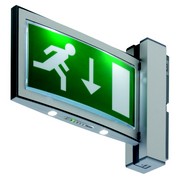Stick with the best quality emergency lighting – or risk the consequences
ICEL - the emergency lighting arm of the Lighting Industry Federation, has voiced its concern about the number of poor quality emergency lighting products on the UK market. “Only products complying with BSEN69598-2-22 should be used. Products registered to ICEL 1001 give additional reassurance to users and facilities managers because they confirm this compliance and also that photometric claims have been verified.” An ICEL spokesperson has said.

For manufacturers committed to ensuring fully compliant emergency lighting equipment, the extra demands of complying with the RoHS, WEEE and Battery Directives, plus the REACH Regulations have also added to their costs. This is occurring at a time when the volume of emergency lighting products sold in the UK is growing, but the total market value is in decline, some of which can be attributed to technology and market trends. Lower capacity cells, for example, are now used in self-contained emergency lighting battery packs, reducing costs, but also potentially reducing the average installed emergency lighting illuminance. Emergency lighting experts, such as ICEL member companies, are addressing these trends by improving circuit efficiencies and designing better optical controllers. The result is that when using a good quality, compliant, product users can be confident that escape lighting illuminance still exceeds the minimum specified in BS5266.
Many of the lower cost emergency lighting products, which are thought to represent a significant share of the UK market, appear to be manufactured or imported with little or no understanding of optical control or photometric performance.
The typical 8W bulkhead is a good example, sayd ICEL. Unfortunately, it cannot be assumed that this actually has an output of 8W. A few years ago, such a bulkhead would provide a total flux of around 180 lumens. Today’s technologies provide only 100 lumens but still ensure that the one lux minimum escape route illuminance is achieved. However, a non-compliant low-cost product might, typically, provide only around 60 lumens output and so be unsuitable to provide sufficient illumination to meet the specified requirements. In addition, poor charger and inverter design, and low battery quality, means that battery life can be significantly reduced. Lamps can, therefore, fail prematurely
Because these poorer quality emergency lighting installations fail to provide the legal minimum escape route illuminance, they put at risk the users of buildings and the buildings themselves. Regulations now require that in every organisation there is a responsible person for emergency lighting who has to risk assess their premises and obtain third party assurance for the fire safety equipment. Any failure that leads to loss of life, personal injury or damage to property will expose these responsible persons, and possibly the installers too - with criminal prosecution and damages claims through civil courts being very possible.
Poor emergency lighting performance of non-compliant products is only part of ICELs concern, however, as suppliers must also comply with environmental regulations. Untraceable hazardous substances could well have been used, so emergency lighting equipment can reach the end of its life with no way of ensuring that it is properly collected and recycled.
Consider that same 8W bulkhead. A compliant manufacturer uses suitable electronic components and non-lead solder to be RoHS compliant. It is also pre-registered for the REACH Regulations, and belongs to a collective recycling scheme for WEEE Directive compliance. Finally, its battery supplier offers a battery take-back scheme, and its lamps will come from a WEEE registered supplier.
All suppliers, whether they be UK/EU based manufacturers or importers are also legally responsible as ‘producers’ for the compliance of their equipment, but do they always meet these responsibilities in full? This is another compelling reason to use only emergency lighting equipment from expert manufacturers, distributed through reputable electrical wholesalers and suppliers.
One way of telling whether an emergency lighting product meets the regulations is to look for the CE mark - mandatory for all luminaires on sale in Europe. This is the manufacturer’s declaration that the product conforms to all relevant European safety standards. Some low-cost non-compliant emergency lighting products may not be CE-marked or possibly the CE mark might be bogus, which is much more difficult for buyers to determine.
Contact Details and Archive...
Related Articles...